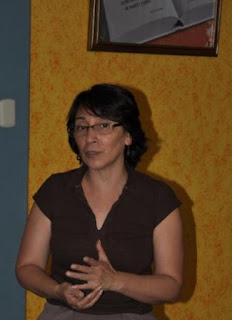MIA’s first meeting of the day was an 11am appointment at the United States Embassy with the U.S. Embassador to Guatemala, Stephen McFarland (“The Unusual Diplomat,” in the July 13 issue of El Periodico Guatemala, www.elperiodico.com.gt). Accompanying us was Gladys Monterrosa, the wife of the ombudsman, who was recently a victim of horrific rape and violence. In demonstration of Guatemala’s system of severe injustice for women, Gladys testified her experience and the extremely flawed investigation that followed.
During the investigation, no efforts were made to gather information or evidence from Monterrosa regarding her experience. An investigator, however, visited Monterrosa’s office and interviewed her assistant. He asked questions about Monterrosa’s salary, money spent, and call history, among other irrelevant inquiries. Additionally, the investigator asked about the office assistant’s marital status, which at the moment was single. Later in the investigation, this information was used against her to build the defense against Monterrosa’s case – the office assistant had since married, yet because she had previously stated that she was single, she was considered a “liar” in order to discredit Monterrosa’s case. Since the investigation began and was picked up by the CICIG Rincon, all of the questions asked of Monterrosa have to do with personal matters instead of details of her assault. Monterrosa noted that there has been no investigation of any potential suspects – the only one being investigated is Monterrosa herself.
As her husband was suspected to eventually run for office, some believe that successful prosecution in Monterrosa’s case would amount to sympathy for the family and result in an increase in women’s votes. Monterrosa’s brave testimony gave MIA an important opportunity to show that impunity, especially in cases of violence against women, affects even the upper class.
Embassador MacFarland commended Monterrosa’s courage and says that he has faith that the CICIG will eventually lead her to justice. Keeping in mind that Monterrosa’s tragic case is all too familiar in Guatemala, McFarland said that the solution to the profound problem of violence against women must be recognized and dealt with from within the justice system, as well as changes to the overall mindset of society. He noted the implementation of USAID to the Guatemalan government to combat impunity, as well as potential police reform – both of which, provoked by questions from two of the delegates, resulted in two more related invitations for appointments for MIA later on in the week.
 MIA’s next meeting was with the First Lady of Guatemala, Sandra Colom. As we had been learning a great deal thus far about the impunity system, it was helpful to learn more about what Colom believes to be the major factors that add to such violence in the first place. She asserted that femicide and other violence is not only a problem of law, but that it is a social systemic problem that starts at home, facilitated by “machismo” culture, poverty, poor health, and lack of education.
MIA’s next meeting was with the First Lady of Guatemala, Sandra Colom. As we had been learning a great deal thus far about the impunity system, it was helpful to learn more about what Colom believes to be the major factors that add to such violence in the first place. She asserted that femicide and other violence is not only a problem of law, but that it is a social systemic problem that starts at home, facilitated by “machismo” culture, poverty, poor health, and lack of education.
Colom was candid in her responses. Admitting her regrets that she has been so overwhelmed with the seemingly infinite problems that plague Guatemala, she admits that she has not been able to focus a significant amount of time and energy to the issue of femicide. She discussed the new series of social programs called “Consejo de Cohesion Social,” which, according to Colom, do address what she considers to be factors that contribute to violence – particularly poverty and education. Addressing the high illiteracy rate among indigenous women, financial dependence of women on their husbands, domestic violence, the overall malnutrition of society, and intergenerational poverty, Colom hopes that as long as these programs generate results, they will continue in the coming years. She noted that the economic elite, however, will likely be the main obstacles to the success of these programs, as interruptions of the cycles of poverty and violence are contrary to their political agendas.

MIA’s third meeting of the day was with Fundacion Sobrevivientes (Survivors Foundation), an organization that works to ensure justice for women in cases of rape, sexual violence, illegal adoptions, and other crimes, as well as provides a shelter when necessary. It was founded in 1999 by Norma Cruz and her daughter, Claudia Maria Hernandez Cruz, and plays a vital role in intervening in women’s legal cases that would otherwise be subjected to the injustice of impunity. Norma, pictured above, was awarded the “Women of Courage” award this year by the Obama administration.
They essentially “make a system work that doesn’t want to work,” according to Eugenia, the assistant to Norma Cruz who spoke with us. Aside from the improbable circumstance that a woman would be able to find justice in the Guatemalan system on her own, most women with whom Fundacion Sobrevivientes works cannot afford the high cost of legal systems – so the organization provides its services for free.
Currently in the center of the foundation’s heart is the issue of illegal adoption, for which Norma Cruz told us she was planning a hunger strike. At the subject of the strike are three different cases whose scenarios are all too familiar for Guatemala. In many cases, a young child or infant may be abducted and declared “abandoned,” yet when a mother may come forward, the defense facilitating the illegal adoption claims that the mother is too impoverished to provide a decent life for the child.
In one of the cases for which Sobrevivientes is protesting, a woman had left her infant with a relative while she went grocery shopping. While she was gone, someone entered the house claiming to have been told by the mother to pick up the child, and kidnapped her for a lucrative illegal adoption in the United States. Because illegitimate procedures were followed in each three cases, Sobrevivientes is calling for legal procedure both in Guatemala and in the U.S. to void all three adoptions.
Norma Cruz, along with Sheryl Osborne – an American working with orphans in Guatemala – have both said that they are willing to starve to death in the hunger strike if all three children are not returned home. Learning about the important work that Fundacion Sobrevivientes does for women in Guatemala and the amazing strength of Norma Cruz, we gained tremendous inspiration for the rest of our delegation and for our work in the U.S. in the future.
 Malnutrition is an underlying cause in more than half of the 25,000 daily, preventable deaths of children.
Malnutrition is an underlying cause in more than half of the 25,000 daily, preventable deaths of children.










 Proud Founder Member of the Guatemala Peace and Development Network
Proud Founder Member of the Guatemala Peace and Development Network